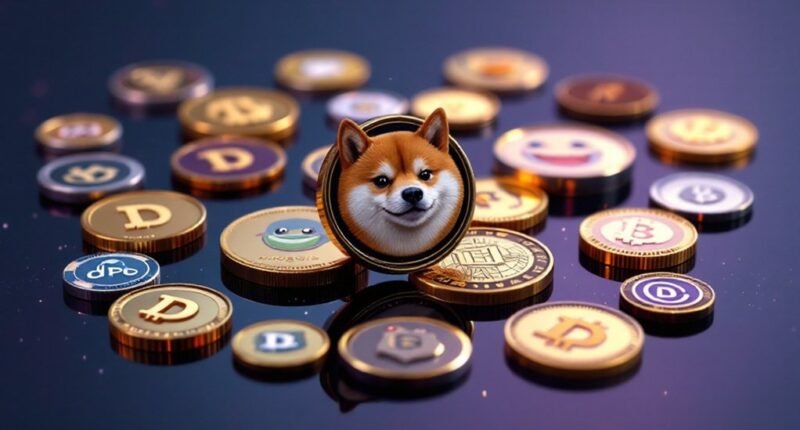Meme coins represent a playful yet influential segment of cryptocurrency, with Dogecoin leading as the original viral digital currency. Notable players include Shiba Inu, which saw astronomical gains in 2021, and newer entries like Pepe and Floki Inu. The market has exploded to a $120 billion cap in 2024, driven by social media buzz and community engagement rather than technological fundamentals. While highly volatile, these coins continue reshaping how investors view digital assets and their potential.

In the wild west of cryptocurrency, meme coins stand out as the court jesters of digital finance – playful, unpredictable, and occasionally capable of stealing the spotlight from their more serious counterparts. Since the creation of Dogecoin in 2013 as a Bitcoin parody, these internet culture-inspired tokens have evolved from simple jokes into significant market players, sometimes generating returns that make traditional investors’ heads spin.
The meme coin landscape is dominated by several key players, each with its own quirky identity. Dogecoin, featuring the beloved Shiba Inu dog meme, paved the way for an entire ecosystem of animal-themed cryptocurrencies. Its successor, Shiba Inu (SHIB), branded itself as the “Dogecoin killer” and achieved a mind-boggling 49,000,000% price increase in 2021. Other notable entries include Pepe, based on the infamous frog meme, and Floki Inu, named after Elon Musk’s dog. The explosive growth has led to fifteen meme coins being listed on Binance. The market is now seeing a rise in theme-based ecosystems that extend beyond traditional canine mascots.
From Dogecoin’s playful pup to Shiba Inu’s meteoric rise, meme coins have transformed internet culture into digital gold rushes.
These digital tokens operate on a unique formula: take one part internet culture, add a dash of social media hysteria, and mix well with cryptocurrency technology. The result? A market segment that grew 500% in 2024, reaching a staggering $120 billion market cap. Unlike their more serious cryptocurrency cousins, meme coins derive their value primarily from community engagement and social media buzz rather than technological innovation or practical utility. As traditional banking faces disruption, these tokens represent a shift toward decentralized finance and greater financial autonomy.
However, the world of meme coins isn’t all rocket ships and moon landings. These tokens are notorious for their extreme volatility, making them as dangerous as they are exciting. Their prices can skyrocket based on a single tweet from a celebrity or plummet just as quickly when the hype fades. While some investors have struck digital gold, others have learned harsh lessons about the risks of following internet trends with their investment dollars.
Looking ahead, meme coins are evolving beyond their joke origins, increasingly integrating with DeFi platforms and NFT ecosystems. While their future remains uncertain, one thing is clear: these playful tokens have permanently altered the cryptocurrency landscape, proving that sometimes, the market’s biggest jokes can deliver serious results.
Frequently Asked Questions
Can Meme Coins Be Used for Real-World Transactions and Purchases?
While meme coins can technically be used for transactions, their real-world utility remains limited.
Only a handful of merchants accept popular meme coins like Dogecoin, and high volatility makes pricing challenging.
Technical limitations, including slow transaction speeds and high fees, further restrict practical use.
However, some niche applications exist, such as online tipping and gaming rewards, and future developments in technology could expand their transactional capabilities.
What Security Risks Should Investors Consider Before Buying Meme Coins?
Meme coin investors face multiple security challenges, including smart contract vulnerabilities that hackers can exploit, and the prevalence of scams like rug pulls where developers abandon projects after collecting funds.
Exchange hacks, phishing attacks, and wallet breaches also pose significant risks. Additionally, pump-and-dump schemes and market manipulation are common in meme coin trading.
The lack of regulatory oversight means investors have limited protections if security breaches occur.
How Do Social Media Influencers Impact Meme Coin Prices?
Social media influencers greatly impact meme coin prices through their massive follower reach and market-moving posts. Single tweets from celebrities can trigger 20-50% price spikes, while coordinated promotion campaigns across platforms like Twitter, TikTok, and Reddit can create artificial hype cycles.
However, data shows 76% of influencer-promoted meme coins lose 90% of their value within three months, often leaving retail investors with substantial losses while promoters profit from undisclosed pre-holdings.
What Percentage of Meme Coins Survive Beyond Their Initial Hype Phase?
Based on market data, only 3% of meme coins survive beyond their initial hype phase.
The statistics paint a stark picture: 15% die within 24 hours, 31% within a week, and a staggering 97% fail within their first year.
Among the tiny fraction that endure, success typically hinges on developing real utility, maintaining strong community engagement, and establishing strategic partnerships beyond the initial social media buzz.
Are Meme Coins Regulated Differently From Traditional Cryptocurrencies in Various Countries?
Most countries regulate meme coins similarly to traditional cryptocurrencies, with some notable variations.
While the US SEC doesn’t consider meme coins as securities, the EU’s MiCA regulation treats them like other cryptos.
Japan includes them under the Payment Services Act, and Singapore classifies them as digital payment tokens.
Only a few jurisdictions, like El Salvador, explicitly differentiate meme coins in their regulatory frameworks.
China’s blanket crypto ban applies equally to all digital assets.









